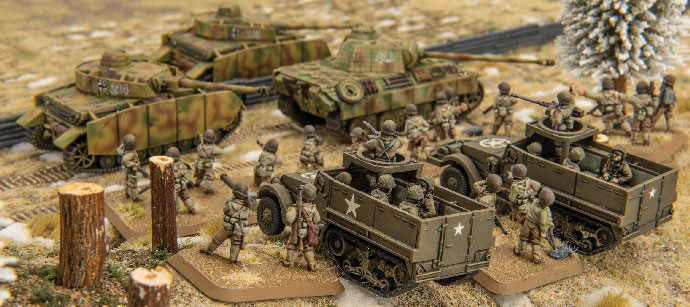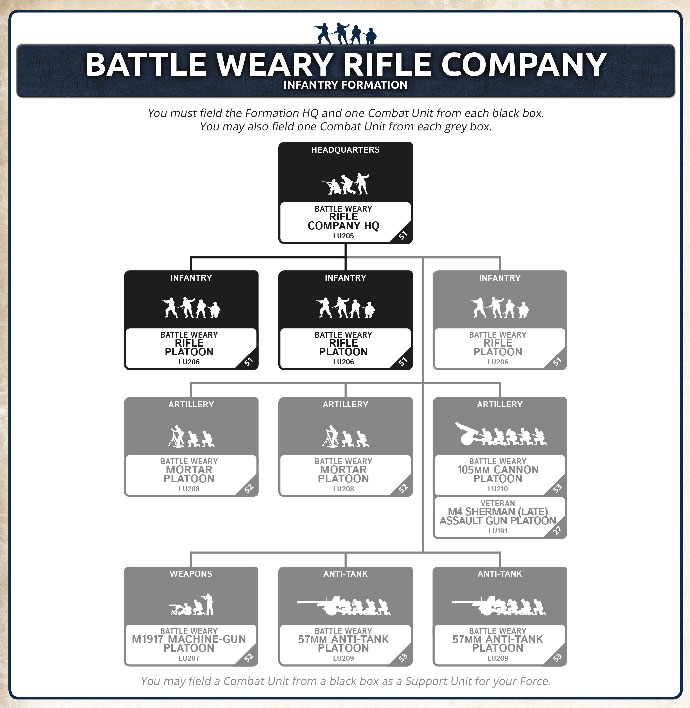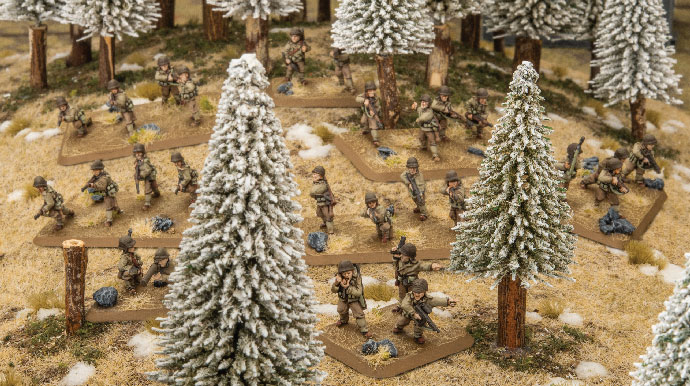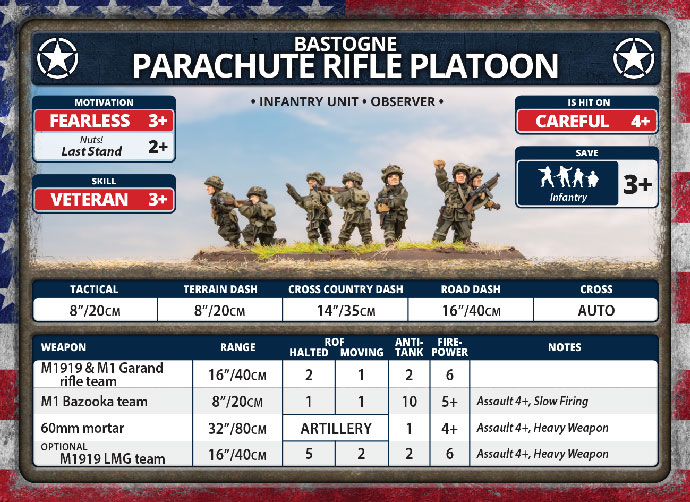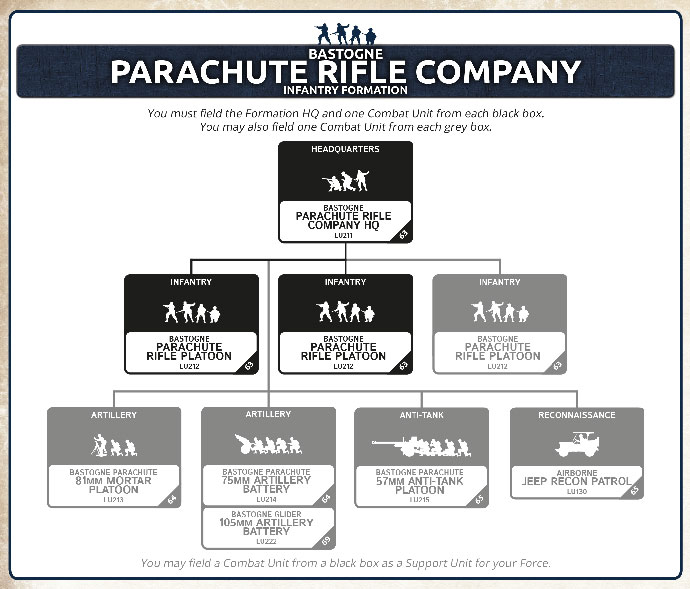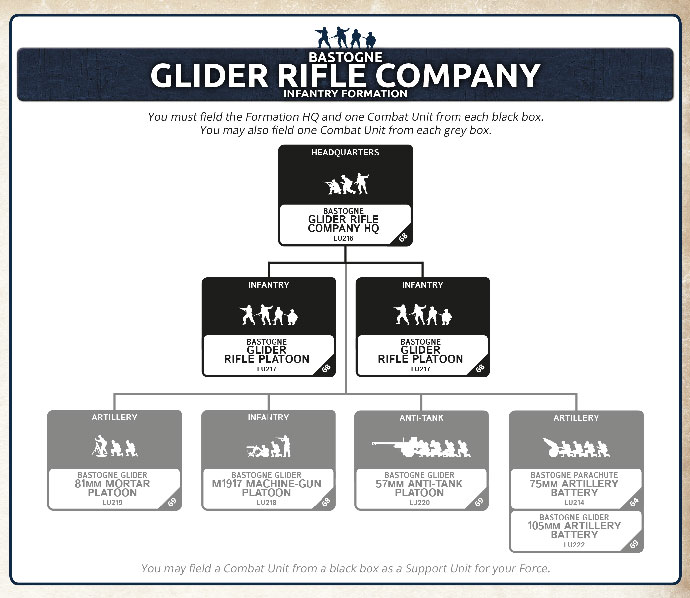With Livio Tonazzo
The beautiful new book Bulge: American allows players to field brand new tanks. Surely the Jumbo and Easy Eight will have caught your attention too? However, true romantics know that the infantry is the queen of battles and the new book certainly doesn’t leave romantics like me disappointed. Bulge: American allows you to deploy four infantry formations. In the article we will review them to learn more about how they are composed, their training, their motivation, their strengths and even those of weakness.
Battle Weary Armoured Rifle
Given that the new book is heavily focused on the new American tanks, it is not surprising that the first proposed infantry formation is the Armoured Rifle, the mechanized infantry that is able to keep up with the armoured spearheads of the United States Army.

Armoured Rifle Company units are veteran units hardened from years of war. Some have served in North Africa and Italy while the less experienced departments are still active in Europe since D-Day. All of these experiences are represented in the game by the Is Hit On value which is Careful 4+. This is the best value available and has a big impact on the gaming table. Taking advantage of a cover or even just being stationary in open field the infantry becomes concealed and will be hit at 5+. We went from a 50% to a 33% chance of being hit. If they do not fire while concealed the opponents need a 6+ so they will only hit the target 16% of the time. This makes Careful infantry such as Battle Weary Armoured Rifles a great option for garrisoning targets as they can take a lot of fire with low casualties. This is also true of artillery fire which is particularly effective against infantry.
The Carful rating also gives it an important advantage during assaults. Since an attacking unit is knocked back by defenders if it is hit by 5 or more hits (unless it is Large Platoon) and having a 50% chance of being hit helps a lot. Even without concealment or smoke the defender will need 10 hits to pin a Battle Weary Armoured Platoon, statistically speaking. Unfortunately I have happened to see my own platoons pinned by only 5 shots but using concealment or smoke is always a good idea.
Despite the experience accumulated in months of battles, the skill of the Armoured Rifle Platoon is that of Trained 4+. This is a fine rating and it helps keep the unit price down points wise. The Yankee Ingenuity rule allows you to pass Tactics tests at 3+. This is an important bonus that is very useful for many things such as overcoming minefields, acquiring a great shooting position thanks using Blitz or get out of a bad situation with a Shoot & Scoot.
As we have said, many veteran infantry formations have been in combat since the Normandy landings on 6 June 1944 and then crossed France to the German border. These troops have extensive experience but have had little respite from the fighting. They tend to be more cautious and less aggressive. Their morale is therefore Reluctant 5+. However they have the Blood ‘N Guts rule which grants them an improved Rally score of 4+. This helps them get back up when pinned down but overall you need to be cautious and avoid taking too many losses.
The Armoured Rifle Formation has three compulsory slots consisting of an Armoured Rifle HQ and two Armoured Rifle Platoons with a third Armoured Rifle optional. The formation also has heavy support with M1917 heavy machine guns equipped with transport if necessary, an anti-tank support with its 57mm also equipped with transport if necessary and two artillery supports. In addition to the M3 Armoured 81mm Mortar consisting of three pieces the formation has a platoon of M8 Scott Assault Gun. This is a rather expensive unit but it is undoubtedly very versatile on the battlefield as it can both bombard and hunt down enemy armoured cars.
The Armoured Rifle platoon naturally deserves an honourable mention. A full strength platoon consists of 6 M1 Garand Rifle Team bases great for assaulting and marking, 2 M1919 LMG bases to manage infantry and provide suppression fire, 5 bazookas to manage tanks and even a 60mm Mortar that adds a bombardment. In total, there are 14 infantry bases that can effectively manage almost all situations that arise in front of them. There are very few adversaries capable of posing a serious threat. Assaulting an Armoured Rifle Platoon requires very careful preparation in terms of attrition and it is practically impossible to succeed without having first bombed intensely and launch a smoke bombardment. As if that were not enough the Armoured Rifle can count on 5 M3 Half-trucks. There are no substantial differences from the M3 Half-trucks we already know, except for the fact that two of them are armed with .50 “instead of .30”. These machine guns are much more effective than their light counterparts and can also be used comfortably against armoured cars or lightly armoured vehicles. The other interesting thing is that the Armoured Rifle Platoon can be chosen without the Half-trucks as very often these units were used in the mud of the Ardennes. I personally find the transports to be very much worth the points cost, allowing the unit to both zip up the field or hide the teams inside the relative safety of a transport . Giving up the transport saves some points but it means giving up on mobility. If desired the platoon can be also be chosen at a reduced size, giving up an M1 Garand Team and a Bazooka Team and saving a few points.
Overall the Armoured Rifle Formation is a truly complete formation, almost a miniature force. It has incredible infantry, fairly effective anti-tank weapons, extra anti-infantry weapons if needed, and two self-propelled artillery platoons that can fire smoke and bomb from a distance. The point cost of course is not cheap, but having low to medium morale and a trained skill helps to keep costs down. I am convinced that the Armoured Rifle Formation will be one of the most popular formations of the new book.
Battle Weary Rifle
Nearly all armies have a Rifle Formation and of course Bulge: American is no exception! The formation that we have already seen in the previous book is named in Battle Weary Rifle. As the name suggests this formation shares the same rating as “Is hit on”, skill and motivation with its Armoured Rifle “cousins”. These are therefore difficult teams to hit, with adequate training, good tactical versatility thanks to the 3+ tactics but a mediocre morale only partially offset by a 4+ Rally. Also in this case the lack of morale helps a little to contain the cost in points.
The Battle Weary Rifle formation has one HQ platoon and two Rifle platoons as compulsory choices. A third Rifle platoon is an optional choice. The formation also has support that make it able to face almost all situations, at least in defence.
First up is the artillery. The Battle Weary Rifle Company has two mortar platoons. Each platoon can be equipped with 81mm or 60mm mortars. The effectiveness is exactly the same as that of all other mortars of the same type. What changes is the range, 40 inches for the classic version and 32 inches for the smaller one. However both can fire a smoke bombardment. The platoon size is the same as D-Day: American if you choose the 81mm mortar: two, four or six pieces. The cost is slightly lower due to the worse rating which makes it very good value for points. The 60mm platoon can only consist of three stands at a low cost. But the artillery component of the formation does not end there. A third slot is available and can consist of a 105 Cannon Platoon or a Veteran M4 Sherman Assault Gun Platoon. The first is a platoon of light howitzers. They have the same effectiveness as the 105 (3/3 +) field howitzers but a much lower effectiveness on direct firing. This is certainly not a big problem. The platoon can consist of two, four and six pieces. At full strength the platoon costs a little over a dozen points, not too much for the support they give in terms of artillery. The Sherman Assault Gun platoon is the same as D-Day: American version. These are a great choice since they are self-propelled assault guns resistant to both enemy artillery and opposing light units. The cost is not exactly cheap but this can be an important investment that will sometimes pay for itself.
The Battle Weary Rifle formation also has two slots for anti-tank guns. The excellent 57mm, which had already given good evidence of him in D-Day: American, continues to protect American infantry from enemy tanks. Sure, an anti-tank value of 10 is starting to not be as effective against enemy tanks that often have a fairly high front armour but the point cost is more than affordable. With a command card it is also possible to remove the No HE rule making them more effective even against enemy infantry and cannons. A couple of 57mm platoons are usually a good investment.
Last but not least is the good old heavy machine gun platoon. There is no big news in this respect, if you are looking for a way to manage enemy infantry spending a handful of points this way is always a good idea.
Overall the Battle Weary Rifle Formation is a very solid and versatile formation. With two sizable infantry platoons, two mortar platoons, and two antitank gun platoons, you’ll have a base to handle almost everything but the heaviest units. In order to deploy high anti-tank guns, it is therefore necessary to resort to supports. There is no need to worry, as the point cost of the formation should leave enough points for all possible choices. If you are looking for an all-in-one training, this is the right training.
Bastogne Parachute Rifle Company
Of all the units that fought valiantly at Bastogne the parachutists were the ones that endured the most tremendous efforts. Isolated in the forest, outnumbered and with very few supplies, they resisted every German attack. The exploits of that band of brothers are now legend and it is logical that even on the tables of Flames of War they are represented as the best of the best. The ratings are pretty much the best in the game. They are Careful, Fearless and Veteran. No other rating would have been more suitable! Now to represent the stubbornness, they have a Last Stand 2+. Whatever happens (snake eyes aside!) You can rest assured that the Parachutists will not retreat, resisting to the last man. Currahee!
The Bastogne Parachute Rifle Formation must consist of one HQ and two units of Bastogne Parachute Rifle Platoon. A third platoon can be chosen to reinforce the formation and add more diehard infantry bases. A Bastogne Parachute Rifle Platoon consists of 5 or 7 bases armed with M1919 and M1 Garand rifle team, one equipped base with 60mm mortar and another armed with the deadly M1 Bazooka team. This gives the platoon great versatility, being able to bombard opposing gun teams and repel an armoured assault thanks to the Bazooka or infantry thanks to the rate of fire 2 on the Riflemen bases. The combination of ratings, of which we have already spoken and of equipment is certainly not cheap. That’s at least a dozen points for the smaller platoon and even more for a full-size version. Additionally with a very small investment it is possible to add a second Bazooka for extra anti-tank support and up to two M1919 LMGs to help the platoon manage the infantry. A Bastogne Parachute Rifle Platoon can cost nearly a fifth of the points on a standard 100 list but trust me: no one can ignore it!
The formation can count on a fair component of artillery, anti-tank and even reconnaissance. A platoon of 81mm mortars on 4 pieces provides a support that is not exactly cheap (the cost is not much less than ten points) but very effective. A second artillery slot is dedicated to the Bastogne Parachute 75mm Cannon Battery or the Bastogne Glider 105mm Artillery Battery. The first platoon is a battery of two or four pieces of 75mm light guns. Not very effective in direct fire but still effective against armoured cars and they provide decent artillery support with a firepower of 4+. However the cost is not cheap. The battery lent by the Glider Rifle consists of three or six pieces of the same 105mm lightweight howitzer that we have already discussed.
As for reconnaissance the Bastogne Parachute Rifle formation has a slot inside it unlike many others. The Airborne Jeep Recon Patrol is made up of four jeeps all armed with the deadly .50 Cal. The platoon is capable of producing a massive volume of fire and can also be very useful for handling enemy armoured cars. As non-armoured vehicles they can only count on a save of 4+ however the best defence is to avoid being hit, making use of the Is Hit on 4+ value and the Scout rule along with orders such as Blitz and Shoot & Scott. Try to avoid the machine guns, they can be really lethal. The cost is still very affordable considering that the unit consists of four jeeps. The biggest advantage however is to be able to count on this unit for the morale of the Formation, since it avoids to take the necessary Recon unit as support.
The Bastogne Parachute Rifle Formation is a truly elite formation: expensive and few in number but irreducible. This is a really reliable line-up. Solid both in defence and in attack, it can adapt to any situation thanks to the valiant parachute rifles.
Bastogne Glider Rifle Company
The Bastogne Glider Rifle Company is airborne infantry in the strict sense, that is to say they are not paratroopers. They are a kind of middle ground between the Rifle Company and the Parachute Rifle Company. They maintain an Is Hit On value of 4+ and have Veteran training. Morale wise the Glider Rifles are more motivated than the Battle Weary Rifle / Armoured Rifle but not as much as the Parachute Rifle. On the other hand, taking to the battlefield in the back of a glider requires a lot of coolness! Also thanks to the Nuts rule they have a Last Stand of 3+ which is unlikely to make them leave the battlefield early.
The formation consists of a Bastogne Glider Rifle HQ and two compulsory Bastogne Glider Rifle Platoons. Unlike other infantry formations the company does not have the possibility to take an additional platoon. However the platoons of Glider Rifle are larger than those of the Parachute Rifle Company. The platoon is composed of seven or ten bases armed with M1 Garand rifle, a M1 Bazooka team, an M1919 LMG and finally a team equipped with 60mm mortar. Furthermore a second Bazooka and a second mortar can be added. The extra Bazooka is always excellent, the second is likely to be a bit redundant since one or two mortars have the same effectiveness. In any case it is evident that a Glider Rifle Platoon is fully autonomous on the battlefield, thanks to the good rate of anti-infantry fire, anti-tank equipment and even the possibility of bombarding . Having multipurpose units is certainly not unique in the American army but a composition like that of the Glider Rifle Platoon represents a unit landed behind enemy lines that would have to face any situation, a bit like paratroopers. The cost corresponds with the size and versatility of the unit so also be prepared to spend close to 20 points for a full-size platoon and certainly consider fielding more than the minimum size platoon. Numbers do matter!
In addition to the two Glider Rifle platoons, the formation has two artillery support slots, one anti-tank unit and one anti-infantry unit. Let’s start with the latter since it is the classic platoon equipped with two or four M1917 HMGs to develop an intense volume of fire against the opposing infantry. As for the artillery, the first slot is the mortar platoon. The biggest difference compared to that of the Rifle, in addition to morale lies in the size that can be 3 or 6 mortars strong. The smaller platoon is slightly cheaper than usual while the 6-size platoon is an important investment. The second slot can consist of the Bastogne Glider 105mm Artillery Battery or the Bastogne Parachute Parachute 75mm Artillery Battery. They are the same artillery that we have already had the opportunity to talk about before. Finally, the Glider Rifle can count on the Bastogne Glider Anti – tank Platoon composed of 57mm guns that also equip the common infantry. While the anti-tank rating isn’t overwhelming it’s an important platoon to hold formation.
Overall I think that a Bastogne Glider Rifle line-up is quite successful, able to satisfy those who want to try something different than the Bastogne Rifle but who don’t want a too short line-up like that of the Bastogne Parachute Rifle.
Which support for my infantry formation?
In concluding this article we will look at what support options are best for an infantry formation. This choice depends a lot on how you intend to set up the list. It must be said that there are some fundamental points that need to be addressed. First of all it is certainly the anti-tank component. American infantry suffers from having portable anti-tank with only AT 10. This means that if you are attacked by heavier tanks, you risk running into a lot of trouble. While you can take extra teams of Bazooka (and I recommend you do!) it is certainly a good idea to invest points in M10s or better still M36 Jackson. Having a response to a 9 or 10 front armour will really help your infantry a lot. Even a Sherman platoon perhaps enhanced with Command Cards to have anti-tank 13 could be enough to need but my advice is to separate the roles whenever possible. I mean that it would be better to set the Sherman tanks in a more aggressive stance (perhaps sacrificing quality for the number) in order to have that extra unit capable of winning a decisive assault and defeating the opponent. fielding all 76mm Sherman will not always be possible. Some believe the Stuarts more than suitable for this role (and if you face infantry they are often right), others may prefer more solid Pershing. Whatever your choice, a platoon of tanks will serve to increase your options with an infantry force.
Even the excellent P-47 Thunderbolt is a valid choice because it allows you to reach those units that hide and that it is difficult to reach with an infantry. Of course the plane is always very random, sometimes it is decisive and other times it is a waste of points.
The last thing to consider is to deploy quality artillery. The American infantry are very equipped with mortars, some can even deploy a total of twelve teams! Do not forget that mortars are almost completely ineffective against self-propelled guns and therefore if you do not have other solutions such as the plane you could find yourself losing the gunner duel with the opponent. Keep this in mind before betting everything on mortars which are great but like all things have their limits.
Have fun, riflemen!

